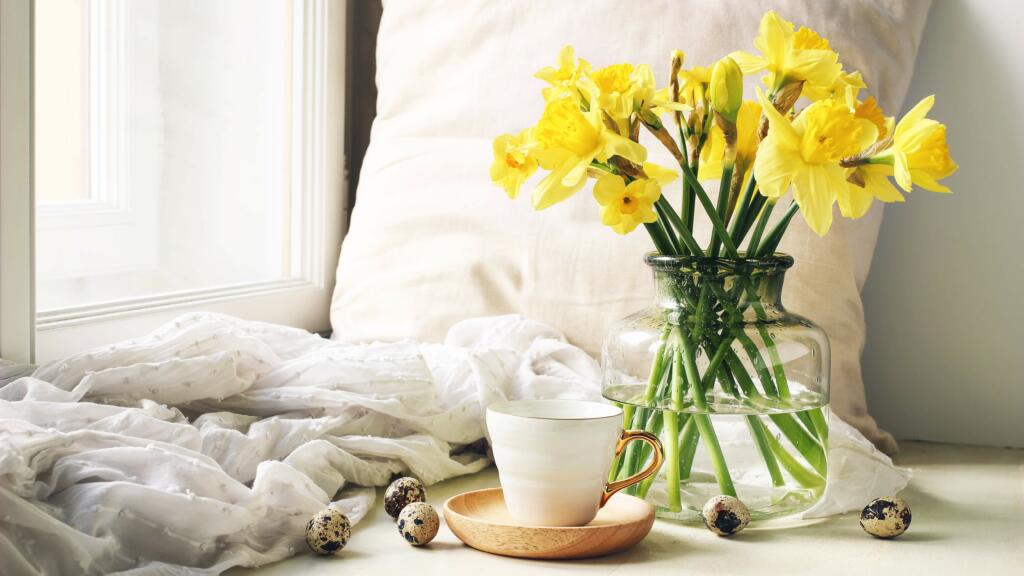
Celebrate snowdrop season with five of the best places to see them
Phillipa Cherryson
Keep the spring in your blooms with these tips.
Does it sometimes feel as though you’re missing a trick when it comes to making daffodils in a vase last longer?
Nothing says winter’s on its way out quite like a fresh bunch of cut daffodils. Their welcoming pop of yellow is enough to brighten any kitchen table, especially after a long stint of spring cleaning.
Does it sometimes feel as though you’re missing a trick when it comes to making daffodils in a vase last longer?
Nothing says winter’s on its way out quite like a fresh bunch of cut daffodils. Their welcoming pop of yellow is enough to brighten any kitchen table, especially after a long stint of spring cleaning.
 Credit: Shutterstock / TabitaZn
Credit: Shutterstock / TabitaZnThough spring is as fleeting as it is beautiful, there’s no reason why you shouldn’t squeeze every last moment of enjoyment out of any lovingly placed daffodils in a vase around your home.
Too often, we buy fresh cut flowers, only for them to last a couple of days before looking tired and wilted, even when we follow the retailer’s instructions.
Thankfully there are a few easy ways you can help your daffodils stay in bloom for as long as possible.
Many cut flower care guides will tell you to trim stems at an angle. But the British Florist Association (BFA) says that bulbous flowers with extremely soft stems (that’s daffodils!) are best cut horizontally.
The flower will absorb water through the soft green part of its stem. Keeping your cut angle at a minimum helps to support this soft stem so that it stays upright for as long as possible.
 Credit: Shutterstock / Ground Picture
Credit: Shutterstock / Ground PictureArena Flowers CEO John Hackett told us you should cut the stems roughly 2-3cm (around 1 inch) from the base using a sharp pair of scissors or the best garden secateurs. Hackett says it’s best to rinse and re-cut your stems every couple of days to maximise freshness.
The BFA suggests you place your daffodils in a vase of cold water. Since most bulbs bloom when the air and ground are still at low temperatures, in early spring, they’ll fare better in a vase of cold water.
 Credit: Shutterstock / Dragon Images
Credit: Shutterstock / Dragon ImagesBut if you’ve bought a bunch of daffs that are still in bud, and you want their flowers to open as soon as possible, warm water will speed up this process.
Hackett told us not to forget to regularly change the water and keep the vase topped up. This reduces the build-up of bacteria in the water.
If you’re harvesting from your own garden, US gardening expert Melinda Myers says it’s best to pick your own in the morning. Rather than just choosing any daff you see, she advises selecting ones with the flower bud just starting to show a bit of colour.
It’s also best to look for flower heads bent at a 90-degree angle from the stem. With plants that have multiple flowers per stem, harvest when one of the flowers is fully open.
 Credit: Shutterstock / encierro
Credit: Shutterstock / encierroHow you cut the flower makes a difference, too. Myers suggests you reach down as far as you can, using a sharp pruner to cut or pull and twist the flower stem so it breaks off at ground level. Don’t pick any leaves, as they provide the food supply for the bulb.
There have been reports of people developing a rash after picking and handling daffodils, so it might be an idea to pop on a pair of gloves, particularly if you have sensitive skin or an open cut. Don’t forget to wash your hands after!
If you need a pair, we have a guide to the best gardening gloves to buy.
Have you ever noticed other flowers wilting next to your daffodils in the vase? That’s because cut daffodils can shorten the life of other flowers when they’re sitting together in the same water.
 Credit: Shutterstock / Bittersweet Stock
Credit: Shutterstock / Bittersweet StockYou can prevent the build-up of toxins released by daffodil stems by changing the water every day, according to florists at Bloomery. They also recommend placing cut daffodils in cool water overnight before popping them in a vase with other flowers.
Or you can keep your daffodils separate from other flowers to extend their life. There is one exception, though. The vase life of irises can be extended by daffodils, thanks to an alkaloid the daffodils produce that slows down the creation of proteins which cause plant ageing. Plus, the purple hues of an iris look fantastic paired with the sunny yellow face of a daff.
In early spring, the quick decline of cut flowers isn’t helped by the central heating still being on, as warm radiators can cause them to dry out.
 Credit: Shutterstock / LightField Studios
Credit: Shutterstock / LightField Studios“Display them somewhere away from draughts, direct sunlight, heat sources and ripening fruit,” says Hackett. “All of these will affect how long your flowers will last.”
A bunch of daffodils might brighten up the kitchen table, but Hackett advises that you remember to remove your fruit bowl and keep it elsewhere. Ripening fruit releases ethylene gas, which can cause cut flowers to age faster.
Despite being a beacon of optimism and a signal of spring for us, daffodils are actually poisonous. If you’re growing them yourself at home, the RHS recommends gardeners keep their daffodil bulbs labelled in bags so as not to confuse them with onions.
This is easier to do than you might think – Marks and Spencer had to issue an apology, after it displayed daffodils right next to spring onions.
This means that daffodils are harmful to our pets, too, so if your cat or dog likes to nibble your houseplants and decorative bouquets, having a bunch of daffodils in a vase at home is a no-go.
 Credit: Shutterstock / Justyna Walak
Credit: Shutterstock / Justyna WalakDaffodils provide some familiar, friendly faces at the end of winter – just when we most need that pop of colour.
So, if you want spring cheer to be in plentiful supply next year, rather than heading to the shops to buy a bunch of cut daffodils, the RHS has this handy guide to growing your own. You don’t need a garden to enjoy them at home, as they can flourish in window boxes and plant pots too.

Written by Rosanna Spence she/her
Published: Updated:
Rosanna Spence has been a journalist for nearly 10 years, reporting on a huge array of topics – from microwaves to cocktails, sustainable buildings, the Caribbean islands and beyond. She’s interviewed chefs at the helm of Michelin-starred restaurants and chatted to countless CEOs about their businesses, as well as created travel guides for experienced travellers seeking life-changing adventures. Throughout her career, she has created content for Business Traveller, i-escape.com, Pub & Bar, BRITA, Dine Out and many more leading titles and brands.

Phillipa Cherryson

Rosanna Spence

Sarah Harley

Rosanna Spence